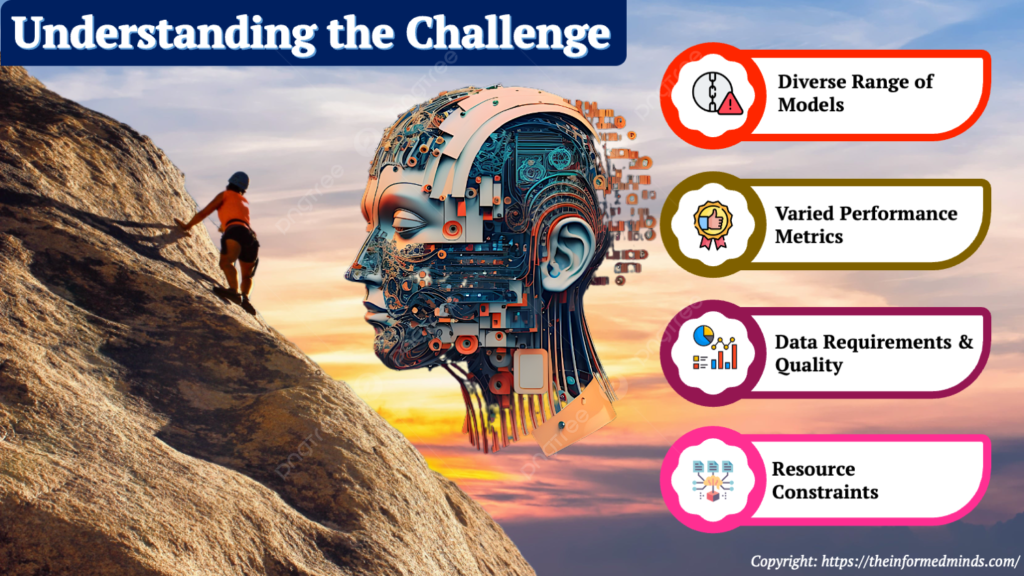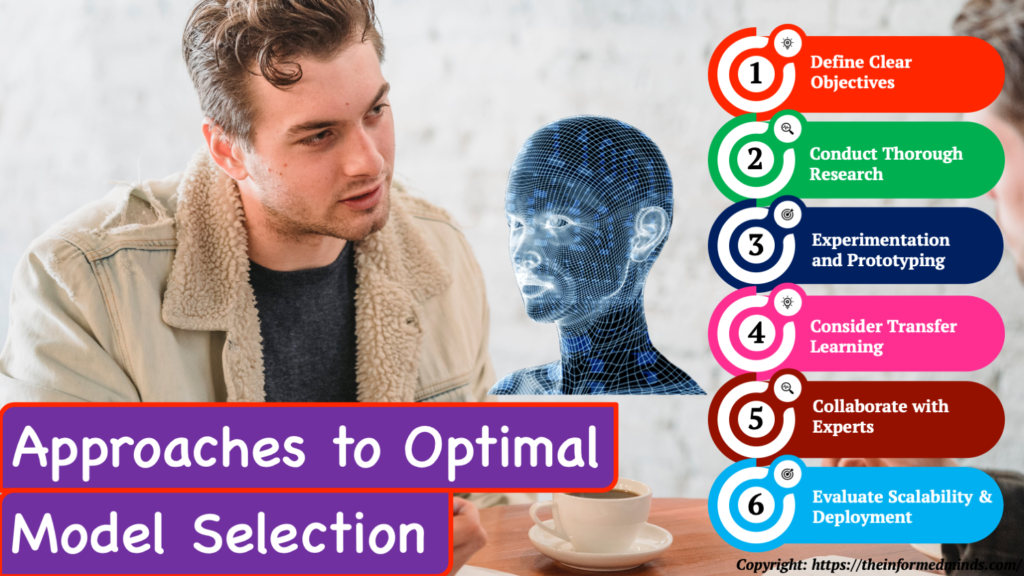To Share is to Show You Care!
In the dynamic landscape of artificial intelligence (AI) development, one of the most crucial yet challenging tasks is selecting the appropriate AI models for specific applications. With the rapid proliferation of AI technologies across various industries, the need for accurate model selection has become paramount. However, navigating through the myriad of available models and algorithms can often be overwhelming, leading to decision paralysis and suboptimal outcomes.
1. Understanding the Challenge
The complexity of selecting the right AI model stems from several factors:

1.1 Diverse Range of Models
The AI ecosystem boasts a diverse array of models, each tailored to address specific tasks and domains. From convolutional neural networks (CNNs) for image recognition to recurrent neural networks (RNNs) for sequential data analysis, the choices can be daunting.
1.2 Varied Performance Metrics
Evaluating the performance of AI models involves considering multiple metrics such as accuracy, precision, recall, F1 score, and computational efficiency. Determining which metrics are most relevant to a particular use case requires careful consideration.
1.3 Data Requirements and Quality
The effectiveness of an AI model is heavily dependent on the quality and quantity of data available for training. Understanding the data requirements of different models and ensuring access to high-quality datasets can be a significant challenge.
1.4 Resource Constraints
Deploying complex AI models often requires substantial computational resources, including GPU-accelerated hardware and specialized software frameworks. Resource constraints can limit the feasibility of certain models for deployment in real-world scenarios.
2. Strategies for Effective Model Selection
While navigating the challenges of AI model selection may seem daunting, implementing the following strategies can help streamline the process and enhance decision-making:

2.1 Define Clear Objectives
Clearly define the objectives and requirements of the AI project, including the specific tasks the model is expected to perform and the desired performance metrics.
2.2 Conduct Thorough Research
Explore the available literature, research papers, and online resources to gain insights into the strengths and limitations of different AI models. Platforms such as arXiv, Google Scholar, and GitHub repositories can be valuable sources of information.
2.3 Experimentation and Prototyping
Develop a systematic approach to experimenting with multiple AI models and algorithms. Utilize frameworks such as TensorFlow, PyTorch, or scikit-learn to prototype and evaluate different models on sample datasets.
2.4 Consider Transfer Learning
Leverage pre-trained models and transfer learning techniques to adapt existing models to new tasks and domains. Transfer learning can significantly reduce the amount of labeled data required for training and accelerate the model development process.
2.5 Collaborate with Experts
Seek guidance from domain experts, data scientists, and AI practitioners who possess specialized knowledge and experience in model selection. Collaborative efforts can facilitate knowledge sharing and lead to more informed decisions.
2.6 Evaluate Scalability and Deployment
Assess the scalability and deployment feasibility of candidate AI models, considering factors such as computational complexity, inference speed, and memory requirements. Choose models that align with the available infrastructure and operational requirements.
Conclusion
In conclusion, selecting the appropriate AI models requires a strategic approach that balances technical considerations, domain expertise, and practical constraints. By understanding the challenges inherent in model selection and implementing effective strategies, organizations can harness the full potential of AI technologies to drive innovation and achieve tangible business outcomes.
As the field of AI continues to evolve, continuous learning and adaptation are essential for staying abreast of emerging trends and advancements. By embracing a proactive mindset and leveraging the collective wisdom of the AI community, organizations can overcome the challenges of model selection and unlock new opportunities for growth and transformation.
Frequently Asked Questions
Q1: How do you select an appropriate problem in AI?
A: Selecting an appropriate problem in AI involves several steps:
- Identify areas where AI can bring value or solve existing challenges.
- Assess the feasibility of applying AI techniques to address the problem.
- Consider the availability of data and resources required for AI implementation.
- Prioritize problems based on potential impact and alignment with organizational goals and objectives.
Q2: How do I choose the right AI model?
A: Choosing the right AI model depends on various factors:
- Define the specific task or problem you want to solve.
- Consider the nature of the data available and the desired outcomes.
- Evaluate the strengths and limitations of different AI models and algorithms.
- Experiment with multiple models and assess their performance using relevant metrics.
- Choose the model that best meets the requirements of your use case and aligns with your objectives.
Q3: What are the difficulties of AI?
A: The difficulties of AI include:
- Complexity in developing and implementing AI algorithms.
- Challenges associated with data quality, quantity, and accessibility.
- Ethical and societal implications of AI technologies.
- Rapid pace of technological advancements leading to skill gaps and knowledge obsolescence.
Q4: What are the 3 main challenges when developing AI products?
A: The three main challenges when developing AI products are:
- Data quality and accessibility.
- Model selection and optimization.
- Integration and deployment of AI solutions into existing workflows and systems.
Q5: How to select the best model to solve a problem in machine learning?
A: To select the best model in machine learning:
- Define the problem and objectives clearly.
- Explore and evaluate multiple algorithms suitable for the problem domain.
- Experiment with different models using cross-validation techniques.
- Consider factors such as performance metrics, scalability, and interpretability.
- Choose the model with the highest predictive accuracy and generalization ability.
Q6: How do you know which algorithm is best suited?
A: Determine the best-suited algorithm by:
- Understanding the characteristics of the problem and data.
- Experimenting with various algorithms and evaluating their performance.
- Considering factors such as accuracy, computational efficiency, and interpretability.
- Consulting domain experts and leveraging best practices in machine learning.
Q7: What makes a good AI model?
A: A good AI model possesses the following characteristics:
- High predictive accuracy and generalization ability.
- Robustness to variations in input data and environmental conditions.
- Scalability and efficiency in terms of computational resources.
- Interpretability and transparency to facilitate understanding and trust.
Q8: How do I know if AI is appropriate for my business?
A: AI may be appropriate for your business if:
- You have access to relevant data for training AI models.
- There are clear use cases where AI can add value or improve processes.
- You have the necessary resources and expertise to develop and deploy AI solutions.
- AI aligns with your strategic goals and objectives for innovation and growth.
Q9: What are the three common AI models?
A: The three common AI models are:
- Neural networks, including convolutional neural networks (CNNs) and recurrent neural networks (RNNs).
- Decision trees and ensemble methods such as random forests and gradient boosting.
- Support vector machines (SVMs) and other kernel-based algorithms.
Q10: What are the three major limitations of AI?
A: The three major limitations of AI include:
- Lack of common sense and contextual understanding.
- Vulnerability to biased or incomplete data.
- Ethical and privacy concerns related to data usage and decision-making.
Q11: What is the biggest problem in AI?
A: The biggest problem in AI is arguably achieving human-level intelligence and understanding, often referred to as artificial general intelligence (AGI). Developing AI systems that can reason, learn, and adapt across diverse tasks and contexts remains a significant challenge.
Q12: Why is artificial intelligence so difficult?
A: Artificial intelligence is difficult due to several reasons:
- Complexity of understanding human cognition and intelligence.
- Challenges in developing algorithms that generalize across diverse datasets and tasks.
- Ethical and societal implications of AI technologies.
- Rapid pace of technological advancements leading to skill gaps and knowledge obsolescence.
Q13: What is one of the three main challenges for AI adoption?
A: One of the three main challenges for AI adoption is data quality and accessibility. Access to high-quality data is crucial for training AI models and ensuring their effectiveness in real-world applications.
Q14: What are the two biggest challenges in developing AI machine?
A: The two biggest challenges in developing AI machines are:
- Ensuring the reliability and safety of AI systems to mitigate potential risks and adverse consequences.
- Addressing the ethical and societal implications of AI technologies, including issues related to bias, privacy, and accountability.
The Informed Minds
I'm Vijay Kumar, a consultant with 20+ years of experience specializing in Home, Lifestyle, and Technology. From DIY and Home Improvement to Interior Design and Personal Finance, I've worked with diverse clients, offering tailored solutions to their needs. Through this blog, I share my expertise, providing valuable insights and practical advice for free. Together, let's make our homes better and embrace the latest in lifestyle and technology for a brighter future.

